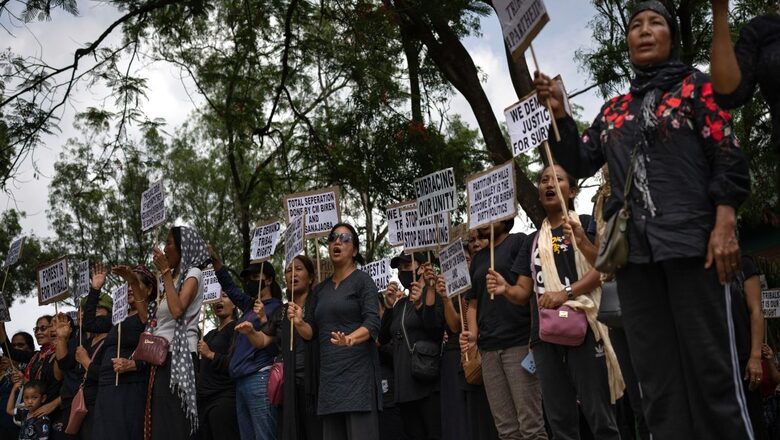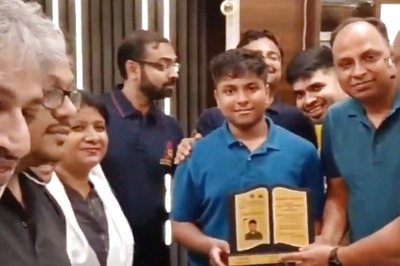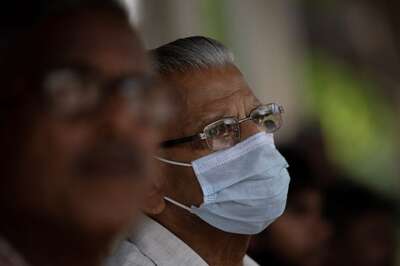
views
It has been more than 75 days of ethnic violence but the Northeast state of Manipur is yet to see the return of normalcy. The ethnic violence between Meiteis and Kuki-Zomis since May has left more than 140 people dead and displaced more than 50,000 people. Taking advantage of this chaos, militant groups belonging to both Meitei and Kuki-Zomi tribes are trying to gain ground among their respective communities, making things more difficult for both the state government and the Centre in restoring peace.
Resurfacing of the old demand of Kukiland
Amid this chaos, the old demand for a separate ‘Kukiland’ has resurfaced. The proposed state is to be curved out from the state of Manipur. Days after starting of the ethnic violence, the demand for a separate administration was raised by 10 Kuki-Zomi MLAs cutting across parties. These included the MLAs from the ruling Bharatiya Janata Party (BJP).
Later, this demand for separate administration got support from civil society groups. Kuki Inpi Manipur (KIM), the apex body of Kuki tribes in the state, has demanded a separate state under Article 3 of the Constitution. On the other hand, Indigenous Tribal Leaders’ Forum (ITLF) has also specified that they are for a separate state or a Union Territory, if a separate state is not agreeable.
Demand for Greater Mizoram echoes
The Kuki-Zomi tribes of Manipur and the Mizos — the dominant tribe of Mizoram — belong to the same Zo tribe. Already, more than 12,000 people from the Kuki-Zomi tribes hit by the ethnic violence have taken shelter in neighbouring Mizoram. It is due to this shared ethnic relation, Mizos are very much concerned with the developments of Manipur. They feel that the current Chief Minister of their neighbouring state, N Biren Singh, is biased against the Kuki-Zomis. They are also supportive of the demand of a separate administration raised by their Kuki-Zomi brethren.
It is another thing that this demand for separate administration is getting support from the political parties of Mizoram, where state assembly polls are due late this year. The BJP unit of Mizoram has passed a resolution supporting the demand for separate administration. Chief Minister Zoramthanga even went one step ahead by bringing the demand of Greater Mizoram, which means uniting areas falling outside Mizoram dominated by the Zo tribes.
This too isn’t a new demand. This was raised in the 1960s when the Mizo National Front (MNF), the current ruling party of the state, was founded. Clearly, with elections near the corner, the Zoramthanga-led MNF is bringing up the issue of Greater Mizoram by milking the unfortunate developments of Manipur to get a political advantage in the polls. The main Opposition, the Zoram People’s Movement, keeping in mind the electoral arithmetic of upcoming polls, too has supported the idea of unification of the Zo tribes.
Separate state not a correct peace formula
The area of the proposed state includes the hill areas of the state where Kukis are dominant. However, this isn’t a simple solution as it seems. It has to be mentioned that Nagas also reside in the hills, which comprise 90 percent of the state’s area. There are 16 districts in the state and of these, 10 come under the hills. Churachandpur district is the main stronghold of the Kukis, who are also spread in districts like Pherzawl, Kangpokpi, Tengnoupal and Chandel.
However, the areas included by Kukis in their “Kukiland” are claimed as their ancestral lands by the Nagas. It has to be mentioned that when Chief Minister Okram Ibobi Singh-led Congress government separated the Kuki-dominated Sadar Hills area from the Naga-dominated Senapati district to create a new district, Kangpokpi, it was opposed by the Nagas, who viewed this as an encroachment on their ancestral lands.
Both Nagas and Kukis have a bitter past. Back in the 1990s, their rivalry resulted in ethnic violence claiming more than 400 lives. This was the worst ethnic violence the state has seen so far. As far as demography is concerned, Kukis account for 30 percent of the state’s population while the Nagas 15 percent.
In the current ethnic violence, the Nagas have stayed neutral so far. However, with the demand for a separate administration gaining momentum among the Kuki-Zomi tribes, the Nagas too have raised their concerns. The state’s water resources minister Awangbow Newmai of the Naga People’s Front, an ally of the BJP, said that the Naga areas shouldn’t be touched as it would create more problems. In June, a delegation of 10 Naga MLAs, including two from the BJP, from the state accompanied by Outer Manipur Lok Sabha MP Lorho Pfoze of NPF, met with Union home minister Amit Shah where they urged the latter not to arrive at any settlement with the Kukis without consulting the Nagas.
Already the Meiteis are clearly opposed to any kind of division of the state’s territory. The Nagas too have issues as their ancestral areas overlap with the areas of the separate state as demanded by the Kuki-Zomi tribes. So any division of the state with the intention to restore normalcy in the Northeast state is likely to only backfire. Any such step has the potential to worsen the current situation instead of bringing peace.
Potential to disturb peace of the Northeast region
There have already been demands for separate states in the Northeast like a separate Tipraland or Greater Tipraland in Tripura, a separate Garoland in Meghalaya, a separate Bodoland in Assam, a separate Frontier Nagaland and the Greater Nagalim demand in Nagaland. In fact, the Centre hasn’t agreed to the demand of Greater Nagalim as the proposed area of this land includes territories of Assam, Arunachal Pradesh and Manipur. The demand for Greater Tipraland is also similar to the Greater Nagalim demand.
If the Centre agrees to create a separate state or even a Union Territory for the Kuki-Zomi tribes out of Manipur, the various statehood demands of the region are likely to gain momentum. Such movements may strengthen the various weakened militant groups, who claim to be working for their ethnic communities, operating in the region.
If peace is to be restored in the strife-torn Manipur, firstly, bold political steps rising above electoral arithmetic need to be taken by the Centre. Secondly, the deep mistrust between the two communities has to be gradually reduced. For that, dialogue between the two communities has to be encouraged through a third party, maybe Nagas, who are neutral in this violence and can play a significant role with the help of the Centre. Instead of a separate state, autonomous district councils under the sixth schedule can be granted to Kukis and also to the Nagas, so that the latter too don’t feel that they are neglected. Obviously, this won’t also be easy as the Kukis and Nagas have differences over the area — but this is much better than agreeing to the demand of a separate state, which itself is a problem; not a solution.
The author is a political commentator and tweets @SagarneelSinha. Views expressed in the above piece are personal and solely that of the author. They do not necessarily reflect News18’s views.




















Comments
0 comment